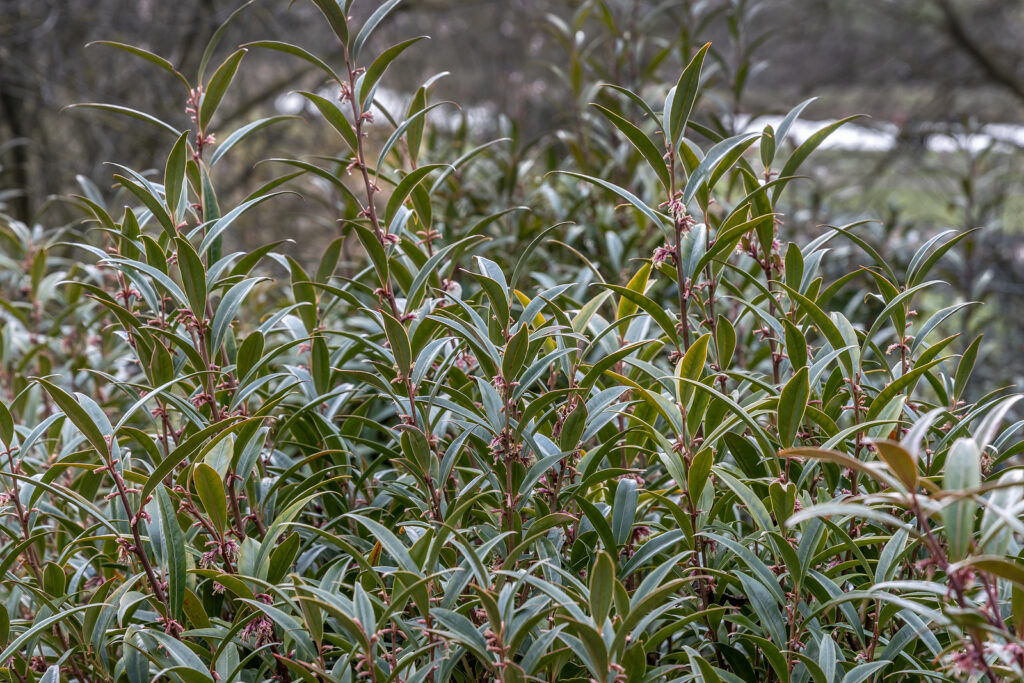Sarcococca — commonly called sweet box–is grown for its handsome, dark green, wavy foliage and for its tiny, powerfully fragrant white flowers which appear hidden in the foliage in late winter and early spring. Sarcococca will grow and bloom in the deepest shade.
Sarcococca is a polished green plant for shaded areas–beneath low growing evergreen trees, under overhangs, and shaded entryways. Sarcococca has a spreading natural habit or it can be sheared and shaped. It will tolerate sun in cool-summer regions.
Sarcococca is a genus of about 14 evergreen species. It is native to moist shady places, forests, and thickets from China to the Himalayas.

Get to know Sarcococca
- Plant type: Low-growing evergreen shrub
- Growing zones and range: Zones 5 or 6 to 8
- Hardiness: Hardy to Zone 6
- Height and width: 18 inches (45cm) to 6 feet 1.8m) tall and 3 to 6 feet (1-1.8m) wide
- Growth rate: Slow.
- Form and habit: Multistemmed, spreading
- Foliage: Long lance-shaped leaves, waxy, lustrous dark green, 2-3.5 inches (5.1-8.9cm) long, similar to boxwood.
- Flowers: Off-white, .5 inches (1.3cm) across, powerfully fragrant flowers, hidden in axils of terminal leaves, small and unimportant.
- Fruits: Shiny and black, rounded, .3 inches (.8cm) across, fleshy and quite decorative, berrylike.
- Bloom time: Spring
- Uses: Underplanting leggy specimens and shrub borders, ground cover and edger in shady, moist situation, useful in shady landscaping areas—under overhangs, beneath low-branching evergreens.
- Garden companions: Mahonias and rhododendrons
- Common name: Sweet box
- Botanical name: Sarcococca
- Family name: Buxaceae
- Origin: Forests and shady places China, Southeast Asia, and the Himalayas
Where to plant Sarcococca
- Plant Sarcococca in partial shade, with two hours of full sun or dappled light all day.
- Plant Sarcococca in well-drained loam, rich with organic matter; pH 5.5 to 6.0; add peat moss, ground bark, or the like to planting bed.
When to plant Sarcococca
- A container-grown or balled-and-burlapped Sarcococca transplants easily in early spring.
- Sow seed outdoors in spring or autumn

Planting and spacing Sarcococca
- Space Sarococca 3 to 6 feet (1-1.8m) apart depending on the variety.
- Sow seed 1/8 inch deep in evenly prepared soil.
How to water and feed Sarcococca
- Give Sarcococca regular to moderate water.
- Keep Sarcococca moist during drought.
- Feed Sarcococca with an all-purpose, organic fertilizer in spring.
How to care for Sarcococca
- Pruning season for Sarcococca is after flowering.
- Little pruning is necessary for Sarcococca, except to cut back ungainly stems or the ground in spring
Sarcococca pests and diseases
- Sarcococca is susceptible to attack by scale insects.
Sarcococca propagation
- Sow seed in containers outdoors in autumn or spring.
- Take semi-ripe cuttings in summer and provide gentle bottom heat.
- Remove suckers in late winter or early spring and replant.
Sarcococca varieties to grow
- Sarcpcpcca confuse, a dense, rounded shrub to 6 feet (1.8m) tall and 3 feet (.9m) wide with elliptical, glossy leaves and clusters of fragrant white spring flowers borne in the leaf axils. The .3 inch (.8cm) fruits are round and glossy black. Zones 6 to 10.
- S. hookeriana, Himalayan or dwarf, sweet box, a cultivar of the handsome 6 foot (1.8m) species, hardy from Zones 5 to 6 to 8. Dwarf sarcococca forms a dense 2 foot (.6m) carpet of shiny, oval, pointed green leaves 1-3 inches (2.5-7.6cm) long, .5-.75 inches (1.3-1.8cm) wide. In March and April, small fragrant ivory flowers appear, followed by a few fleshy berry-like black fruits. Good ground cover.
- S. humilis, Sweetbox, formerly S. hookeriana var. humilis, the most commonly available variety. Averaging 18 inches (45.7cm) tall, it suckers to for a non-aggressive, mounded colony. The 3 inch (7.6cm) dark green leaves usually hide the .5 inch (1.3cm) flowers, white and sweetly aromatic, that bloom late winter to early spring. The fruits are glossy and blue-black. Zones 5 to 10.
- S. ruscifolia, Fragrant sarcococca, a beautiful slow-growing, Chinese species, reaches 4-6 feet (1.2-1.8m) high, 3-7 feet (.9-2.1m) wide, and tolerates winters only in Zones 7 and 8. In early spring it bears small, sweetly fragrant white flowers; red fruits follow. Will form natural espalier against a wall, branches fanning out to create patterns. The plants can be hard to find, but they are lovely growing as understory plants in groves of needled evergreens. Zones 7 to 10.















